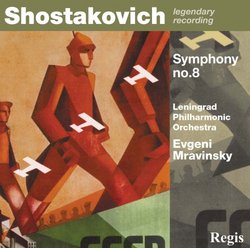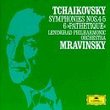| All Artists: Leningrad Philharmonic Orchestra, Dmitry Shostakovich, Yevgeny Mravinsky Title: Shostakovich: Symphony No. 8 Members Wishing: 0 Total Copies: 0 Label: Regis Release Date: 1/1/2006 Album Type: Single, Import Genre: Classical Styles: Historical Periods, Modern, 20th, & 21st Century, Symphonies Number of Discs: 1 SwapaCD Credits: 1 |
Search - Leningrad Philharmonic Orchestra, Dmitry Shostakovich, Yevgeny Mravinsky :: Shostakovich: Symphony No. 8
 | Leningrad Philharmonic Orchestra, Dmitry Shostakovich, Yevgeny Mravinsky Shostakovich: Symphony No. 8 Genre: Classical
|
Larger Image |
CD DetailsSimilar CDs |
CD ReviewsA definitive Shostakovich 8th? Larry VanDeSande | Mason, Michigan United States | 05/16/2009 (5 out of 5 stars) "It may be difficult to designate any recording as being definitive in this remarkable symphony, but if one had to be certified as the exemplar, it would likely be this 1984 concert recording by Evgeny Mravinsky and the Leningrad Philharmonic Orchestra. While great Shostakovich 8s are all over the place, this one holds special allure for collectors since Mravinsky conducted the premiere, was close to the conductor even though they had differences, and his no nonsense temperament fits the bitterness of the music so well.
For the uninitiated, Dmitri Shostakovich (1906-75) was the premier Soviet composer and one of the greatest composers of the 20th or any other century. His 15 symphonies, of which the great 8th sits in the middle, express his musicianship from the time of his conservatory graduation (Symphony No. 1 was his graduation exercise), through the death-grip of the Stalin years where most of the composer's friends perished, to the artistic thaw that existed at the end of his life under Krushchev and Brezhnev that allowed him to experiment with serialism in the final symphony. Most commentators believe it is Shostakovich's so-called "war" symphonies -- Nos. 4-8 -- that are, with No. 10, his greatest. The Symphony No. 8, written during the war in 1943, was for decades considered a Soviet reflection of the war years. Books including Ian MacDonald's "The New Shostakovich" and "Testimony", the composer's own reminiscences as told through Solomon Volkov, help us today understand the symphony is not about war; it is about totalitarianism and the iron rule of Stalin. Having read these books and viewed the DVD "Shostakovich Vs. Stalin: The War Symphonies", I agree with author MacDonald who says the symphonies 4-8 are actually the "terror" symphonies since all were written during the Stalin reign of terror that saw millions imprisoned in the Gulag and hundreds of thousands murdered. The Stalin era in the Soviet Union was a time in the world when murder was official state policy. Thus, knowing Shostakovich's music is full of hidden meaning, I have come to this conclusion about the contents of the Symphony No. 8: 1st movement: right from the minor string strikes that open the music, this is tge mirror of awakening to a new day under totalitarianism. Mravinsky's 25-minute travail is a threndoy on the human spirit being crushed. 2nd movement: I am uncertain about this interlude but think it may be caricature of the individual being confronted by authority in Stalin's Soviet Union by the way it creates heightened heart rate and unease. 3rd movement: this is clearly an example of a day in a Soviet factory of prison labor camp, with the drama, terror, noise and commotion intact. 4th movement: this is the beginning of the end of that day and a time when the individual can begin to relent. 5th movement: here the individual can finally escape the terror by falling asleep and going to a dream world where totalitarianism doesn't exist. Whether I'm all wet, on the money or anywhere in between, Mravinsky and the Leningraders bring these images to life in this exceptionally well-recorded transfer. This is the same recording that exists on Philips and that some commentators have said is transferred a quarter-tone sharp. Its 61-minute duration is in the middle of the pack, faster than Previn's famous recording with Chicago Symphony, in league with Haitink's Concertgebouw recording, and longer than Caetani's 52-minute concert recording for Arts that set a new standard for speed in the music. I've found all four of these recordings have much to say in this symphony but still believe there is only one Mravinsky, whose recording probably earns top billing among all extant varieties of this remarkable music. At the price required here, it's hardly a risk to find out if I'm wrong." |

 Track Listings (5) - Disc #1
Track Listings (5) - Disc #1